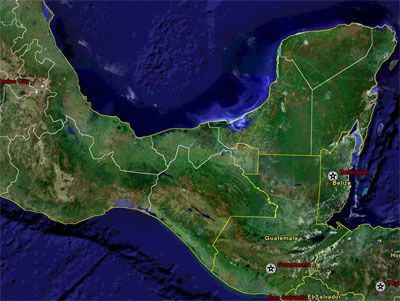GUATEMALA
Please note, this page is not longer being updated. For more recent information, please see news.mongabay.com and use the search function to find the country feed. For more up-to-date data on forest cover and loss, check out Global Forest Watch.
| Guatemala Forest Figures
Forest Cover Total forest area: 3,938,000 ha % of land area: 36.3% Primary forest cover: 1,957,000 ha % of land area: 18.0% % total forest area: 49.7% Deforestation Rates, 2000-2005 Annual change in forest cover: -54,000 ha Annual deforestation rate: -1.3% Change in defor. rate since '90s: 12.8% Total forest loss since 1990: -810,000 ha Total forest loss since 1990:-17.1% Primary or "Old-growth" forests Annual loss of primary forests: -26800 ha Annual deforestation rate: -1.3% Change in deforestation rate since '90s: 12.8% Primary forest loss since 1990: -134,000 ha Primary forest loss since 1990:-17.0% Forest Classification Public: 42.2% Private: 52.5% Other: 5.3% Use Production: 26.8% Protection: n/a Conservation: 62.3% Social services: n/a Multiple purpose: n/a None or unknown: 10.9 Forest Area Breakdown Total area: 3,938,000 ha Primary: 1,957,000 ha Modified natural: 1,859,000 ha Semi-natural: n/a Production plantation: 122,000 ha Production plantation: n/a Plantations Plantations, 2005: 122,000 ha % of total forest cover: 3.1% Annual change rate (00-05): 6,800,000 ha Carbon storage Above-ground biomass: 755 M t Below-ground biomass: 241 M t Area annually affected by Fire: 68,000 ha Insects: 1,000 ha Diseases: n/a Number of tree species in IUCN red list Number of native tree species: 700 Critically endangered: 2 Endangered: 30 Vulnerable: 51 Wood removal 2005 Industrial roundwood: 623,000 m3 o.b. Wood fuel: 18,622,000 m3 o.b. Value of forest products, 2005 Industrial roundwood: $37,709,000 Wood fuel: $159,110,000 Non-wood forest products (NWFPs): n/a Total Value: $196,819,000 More forest statistics for Guatemala |
Guatemala's rural population is among the poorest in Central America. As such, people's day-to-day survival is dependent upon natural resource use. Most rural Guatemalans have few employment options; they must live off the land that surrounds them making use of whatever resources they can find. Their poverty and relative lack of opportunity mean the country's forests are falling at one of the highest rates in Latin America. Official figures show that around 80,000 hectares are deforested annually, though some organizations say the figure may be closer to 95,000 hectares—or 3 percent of the country's forests—per year. Not even national parks are safe. Recent surveys have found extensive illegal logging in the Mayan Biosphere Reserve and the Laguna del Tigre national park. While such logging tends to be destructive, environmental groups are working to develop community-based conservation projects that use sustainable harvesting techniques to reduce the impact on the forest ecosystem.
Most forest loss in Guatemala results from colonization, which leads to agriculture and fuelwood collection. Population pressures around protected areas result in illegal timber harvesting and land clearing for agriculture in national parks. Fires set for land clearing in nearby fields often spread into protected forest areas. For example, in 1998 fires burned more than 160,000 acres (65,000 hectares) of the Maya Biosphere Reserve. While 27 percent of Guatemala's land is protected, most of these areas generally amount to little more than paper parks.
Gold mining, road construction, and land clearing for cattle pasture are also considered important factors in the ongoing disappearance of Guatemala's forests.
The continuing loss of Guatemala's forests could prove costly for the country. New research suggests that the great Mayan civilization of the past was done in by a familiar problem: deforestation. Already deforestation has had a significant environmental impact in Guatemala. In parts of the country soil erosion reduces agricultural yields while deforested hillsides are more susceptible to landslides during tropical storms that batter the country. In 2005, mudslides attributed to tropical storm Stan killed more than 1,500 people in the country.
Recent articles | Guatemala news updates | XML
Suggested reading - Books
- Lonely Planet Guatemala
- The Rough Guide to Guatemala
- Fodor's Belize and Guatemala 2006
- Guatemala Map
- Silence on the Mountain: Stories of Terror, Betrayal, and Forgetting in Guatemala
- Adventure Guide to Guatemala
- A Field Guide to the Mammals of Central America and Southeast Mexico
Unless otherwise specified, this article was written by Rhett A. Butler [Bibliographic citation for this page]
Other resources
Contact me if you have suggestions on other rainforest-related environmental sites and resources for this country.

Image copyright Google Earth, MDA EarthSet, DigitalGlobe 2005
CIA-World Factbook Profile
FAO-Forestry Profile
Last updated: 5 Feb 2006
